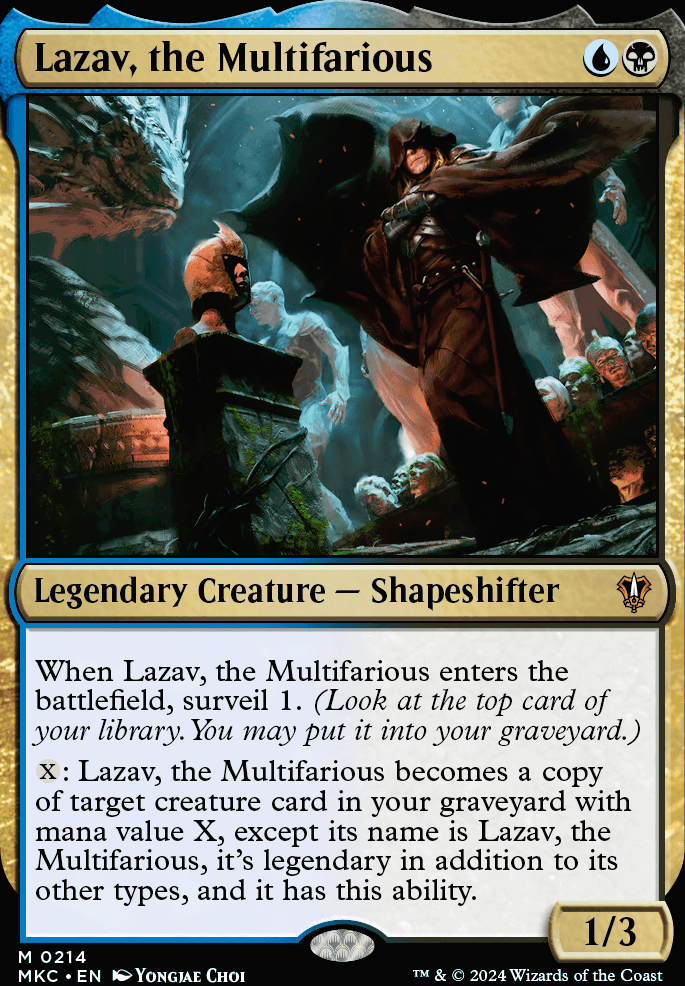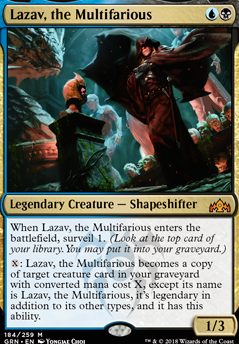Lazav, the Multifarious costs only for a creature with two relevant abilities. In my experience, commanders with such a low converted mana cost are often very powerful in EDH if decks are built around them. Some examples are Baral, Chief of Compliance, Hapatra, Vizier of Poisons, Karlov of the Ghost Council, Rhys the Redeemed, Saffi Eriksdotter, Sram, Senior Edificer, Thrasios, Triton Hero and Zurgo Bellstriker. All of these decks base their strategy around their commander, and they can afford to do so because those creatures cost 2 or less mana. This means that, if they get removed, they can be cast again for a reasonable price. The same is true for Lazav: if he dies, the next time he costs 4 mana. He dies again and costs 6 mana, which is still less than some commanders' initial casting cost. The fact that he can come into play very early in the game also means that he can start attacking as early as turn 3 if we want. As we shall see, we are capable of knocking an opponent out by turn 3 or 4, and that's thanks to Lazav's low CMC. His base power and toughness aren't so relevant, since we will change them as soon as we can. Another thing to note is that he is a shapeshifter, but this is just his creature type: do not confuse that with changeling, which is a keyword that only some shapeshifters have. As a result, Lazav won't be of any creature type, unlike Shapesharer and Mothdust Changeling are. This may sound obvious to a lot of people, but some of my opponents didn't realise that during my first games with this deck.
But let's discuss his abilities, which are very unique:
When Lazav, the Multifarious enters the battlefield, surveil 1.
While this isn't game-breaking by any means, it is nonetheless a nice ability to have "for free". To surveil 1, we look at the top card of our library and then decide whether we want to leave it on top or put it into our graveyard. This effect is very similar to scry, but for us it's better because we need creatures in the graveyard to fuel Lazav's second ability. Having the option to mill a key piece with a surveil trigger is a nice bonus. And even if we don't hit a creature (which is likely, considering we have only 13 in the deck), we can still sculpt our next draw. We can get rid of spells if we need mana, or mill lands if we need gas. Considering we have a guaranteed surveil on turn 2, we can also consider keeping sketchy opening hands because we can basically dig one extra card in our deck. Surveil is useful, but we don't need to dedicate other slots of our deck to it. Loot spells and tutors will serve us better, as they are more reliable. The only reason we play Lazav is his second ability, so that's why I consider his surveil 1 a nice, added bonus.
: Lazav, the Multifarious becomes a copy of target creature card in your graveyard with converted mana cost X, except its name is Lazav, the Multifarious, it's legendary in addition to its other types, and it has this ability.
The whole deck is built around this ability. Let's start by saying that this is not to be confused with reanimation: in Magic, reanimating basically means getting a creature back from the graveyard to the battlefield with a cheaper spell or ability. A basic example can be casting Reanimate on a dead Sheoldred, Whispering One. This differs from Lazav in two, drastic ways: first of all, we are not putting the creature back to the battlefield. It is Lazav that becomes a copy of the chosen creature, so he will already be on the battlefield. This way, any enter the battlefield (ETB) effects won't trigger (we will come to that later). Secondly, and most importantly, we are not saving any mana when we use Lazav's ability. The best thing about reanimation is that we can cheat a creature with a very high CMC into play a lot earlier than normal thanks to a cheap spell like Reanimate or Animate Dead. This is definitely not the case with Lazav, because we have to pay the full CMC of the chosen creature to copy it. Filling our deck with Sheoldred, Whispering One, Razaketh, the Foulblooded and Grave Titan simply won't work. We need a way to break his ability, in the same way that a turn 1 Reanimate breaks Sheoldred. Remember when I mentioned that ETB effects won't trigger with Lazav's ability? Over its history, Wizards has printed a few creatures with insanely high stats and extremely cheap mana costs. To compensate that, they gave them atrocious ETB effects that made them literally unplayable in every format. The best examples are Phyrexian Dreadnought and Hunted Horror. As I have said, their ETBs won't trigger once Lazav is already on the field. This way, we can take advantage of their low CMC and have a 12/12 Lazav for just or a 7/7 Lazav for . From that spot, what we need to do is just protect our general and keep attacking every turn. If we want to save him from removal, we have Invisible Stalker or Cavern Harpy. If we need evasion, we can copy an Ornithopter or Nether Traitor. It's important to note that Lazav doesn't exile the creatures he copies, so we are free to transform him from one creature to another as many times as we please, as long as we have mana available. The fact that we can do this at instant speed is just the icing in the cake. This makes him really hard to deal with for our opponents.
In order to use Lazav's ability effectively, we need to understand how the Combat Phase works. It is divided into five steps:
- Beginning of Combat Step: the initial step of the Combat Phase.
- Declare Attackers Step: the step where creatures may be assigned to attack.
- Declare Blockers Step: the step where creatures may be assigned to block.
- Combat Damage Step: the step where combat damage is calculated.
- End of Combat Step: the final step of the Combat Phase.
What's important to know is that we (and our opponents) can interact with each step by casting instants and activating abilities. This is crucial because we will usually be shifting form more than once during a single combat phase to adapt to the board state.
To explain you how this works, I will give you a practical example:
We have Lazav on the board and Phyrexian Dreadnought and Invisible Stalker in the graveyard. Our opponent has enough creatures to block the 12 trampling damage. We will pay to turn Lazav into the Stalker and then move straight to combat. We will attack with the Lazav-Stalker, which is now unblockable. The opponent can't block, so he or she will skip the declare blockers step. Once we move to the combat damage step, we hold priority and pay to transform Lazav into the Dreadnought. The declare blockers step is over, so Lazav hasn't been blocked, but he will deal 12 points of damage instead of 1 during the combat damage step.
Another common line is the one that involves haste. If Lazav is affected by summoning sickness, we can pay to copy a Banehound and then swing with it. Again, before damage is calculated we are free to change form and copy a bigger creature.
These are just some of the tricks that we are able to do with our commander, but there's plenty more. Lazav is extremely powerful, but I can't stress enough how much fun and unique this playstyle is.


